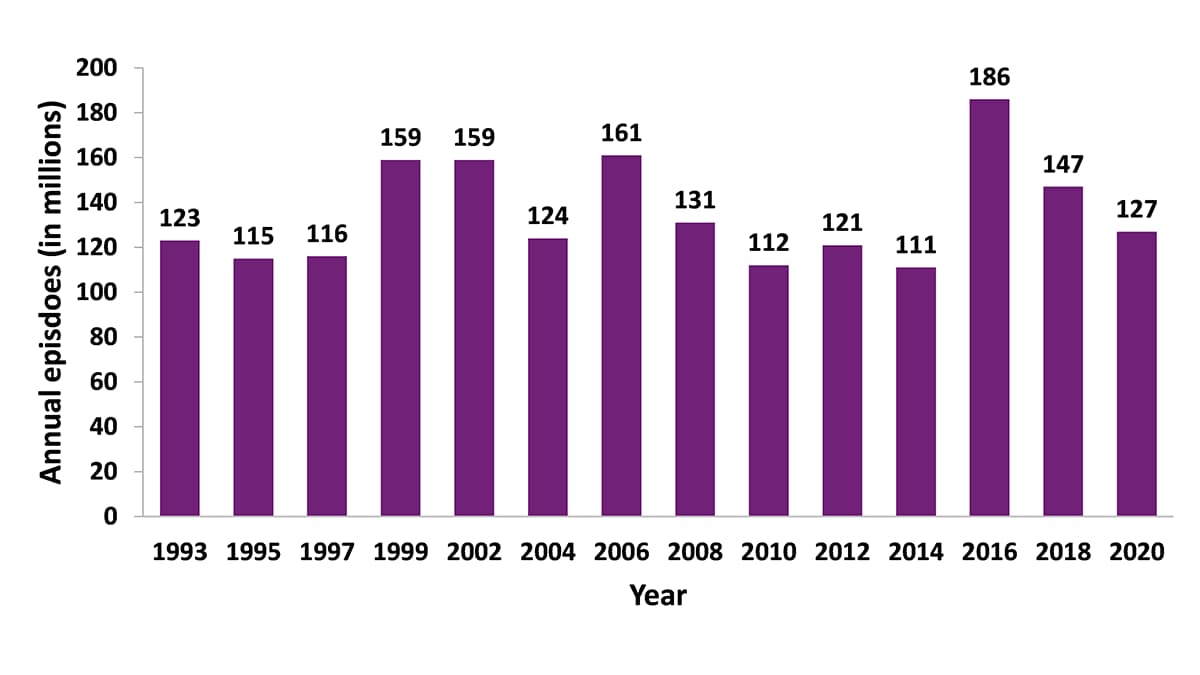At a glance
- Despite the risk, millions of people drive impaired in the United States each year.
- Impaired driving kills thousands of people every year in the United States. These people include the alcohol-impaired drivers themselves, their passengers, drivers or passengers of another vehicle, and pedestrians.
Overview
Alcohol
- In 2020, 11,654 people were killed in motor vehicle crashes involving alcohol-impaired drivers, accounting for 30% of all traffic-related deaths in the United States.1 This was a 14.3% increase compared to the number of crash deaths involving alcohol-impaired drivers in 2019.1
- 32 people in the United States are killed every day in crashes involving an alcohol-impaired driver—this is one death every 45 minutes.1
- The annual estimated cost of crash deaths involving alcohol-impaired drivers totaled about $123.3 billionA in 2020.2 These costs include medical costs and cost estimates for lives lost.
Drugs
It is not known how many people are killed each year in crashes involving drug-impaired drivers because of data limitations.3 However, some studies have assessed drivers for alcohol and drugs in their systems. For example, a study at 7 trauma centers of 4,243 drivers who were seriously injured in crashes found that 54% of drivers tested positive for alcohol and/or drugs from September 2019 to July 2021. Of the 4,243 drivers, 22% were positive for alcohol, 25% were positive for marijuana, 9% were positive for opioids, 10% were positive for stimulants, and 8% were positive for sedatives.4
Who is affected
- 62% of people who died in crashes involving alcohol-impaired drivers in 2020 were the alcohol-impaired drivers themselves; 38% were passengers of the alcohol-impaired drivers, drivers or passengers of another vehicle, or nonoccupants (such as a pedestrian).1
- 229 children ages 0–14 years were killed in crashes involving an alcohol-impaired driver in 2020. This was 21% of traffic-related deaths among children ages 0–14 years.1
Impaired driving behavior
Despite the risk, millions of people drive impaired in the United States each year.
About 1 million arrests are made in the United States each year for driving under the influence of alcohol and/or drugs.56 However, results from national self-report surveys show that these arrests represent only a small portion of the times impaired drivers are on the road.
Results from the 2020 National Survey on Drug Use and Health (NSDUH) indicated that the estimated number of U.S. residents ages 16 years and older who drove under the influence in the past year was:
- 18.5 million for alcohol (7.2% of respondents ages 16 years and older),
- 11.7 million for marijuana (4.5% of respondents ages 16 years and older), and
- 2.4 million for illicit drugs other than marijuana (0.9% of respondents ages 16 years and older).7
Data from the Behavioral Risk Factor Surveillance System indicated that 1.2% of adults drove after having too much to drink in the past 30 days in 2020. This resulted in an estimated 127 million episodes of alcohol-impaired driving among US adults.8

Source: CDC. Behavioral Risk Factor Surveillance System (BRFSS), 1993–2020. Available at https://www.cdc.gov/brfss.
Note: Annual estimated alcohol-impaired driving episodes were calculated using BRFSS respondents' answers to this question: "During the past 30 days, how many times have you driven when you've had perhaps too much to drink?" Annual estimates per respondent were calculated by multiplying the reported episodes during the preceding 30 days by 12. These numbers were summed to obtain the annual national estimates. (See Alcohol-impaired driving among adults—USA, 2014–2018 for more information).
Resources
Related Data Sources
- CDC: WISQARS (Web-based Injury Statistics Query and Reporting System)
- CDC: Behavioral Risk Factor Surveillance System (BRFSS)
- CDC: Youth Risk Behavior Surveillance System (YRBSS)
- Substance Abuse and Mental Health Services Administration (SAMHSA): National Survey on Drug Use and Health (NSDUH)
- National Highway Traffic Safety Administration (NHTSA): Fatality Analysis Reporting System (FARS)
- In 2020 U.S. dollars
- National Highway Traffic Safety Administration (NHTSA). Traffic Safety Facts 2020 Data: Alcohol-Impaired Driving (Report No DOT HS 813 294). Washington, DC: U.S. Department of Transportation, National Highway Traffic Safety Administration, National Center for Statistics and Analysis; April 2022.
- Centers for Disease Control and Prevention (CDC). WISQARS — Web-based Injury Statistics Query and Reporting System. U.S. Department of Health and Human Services, Centers for Disease Control and Prevention, National Center for Injury Prevention and Control; 2022.
- Berning A, Smither D. Traffic Safety Facts Research Note: Understanding the Limitations of Drug Test Information, Reporting, and Testing Practices in Fatal Crashes (DOT HS 812 072). Washington, DC: U.S. Department of Transportation, National Highway Traffic Safety Administration (NHTSA), National Center for Statistics and Analysis. April 2022.
- Thomas FD, Darrah J, Graham L, Berning A, Blomberg R, Finstad K, Griggs C, Crandall M, Schulman C, Kozar R, Lai J, Mohr N, Chenoweth J, Cunningham K, Babu K, Dorfman J, Van Heukelom J, Ehsani J, Fell J, Whitehill J, Brown T, Moore C. Alcohol and Drug Prevalence Among Seriously or Fatally Injured Road Users (Report No. DOT HS 813 399) [PDF – 73 pages]. Washington, DC: U.S. Department of Transportation, National Highway Traffic Safety Administration (NHTSA), Office of Behavioral Safety Research. December 2022.
- Federal Bureau of Investigation (FBI). Crime in the United States 2018: Persons Arrested, Table 29 Estimated Number of Arrests—United States, 2018. Washington, DC: U.S. Department of Justice, Federal Bureau of Investigations, Criminal Justice Information Services Division, Uniform Crime Reporting Program.
- Federal Bureau of Investigation (FBI). Crime in the United States 2019: Persons Arrested, Table 29 Estimated Number of Arrests—United States, 2019. Washington, DC: U.S. Department of Justice, Federal Bureau of Investigations, Criminal Justice Information Services Division, Uniform Crime Reporting Program.
- Substance Abuse and Mental Health Services Administration (SAMHSA). 2020 NSDUH Detailed Tables. Rockville, MD: U.S. Department of Health and Human Services. January 2022.
- Centers for Disease Control and Prevention (CDC). Behavioral Risk Factor Surveillance System. Unpublished analyses, 2020 data.
